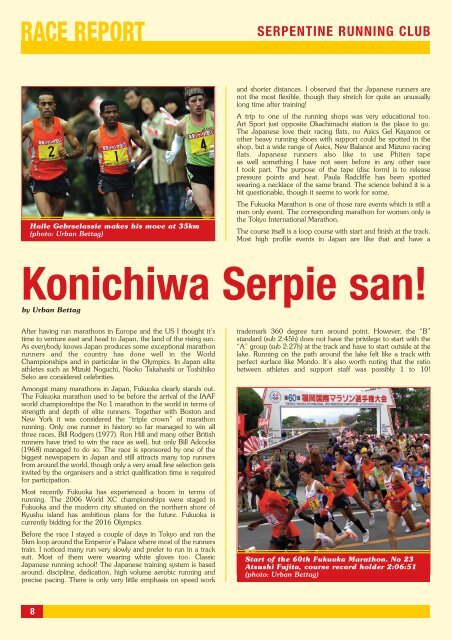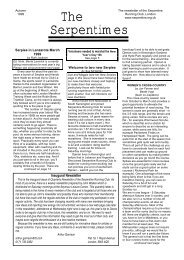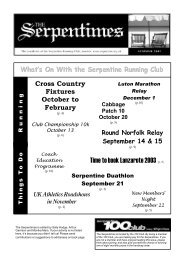AUTUMN 2007 - Serpentine
AUTUMN 2007 - Serpentine
AUTUMN 2007 - Serpentine
Create successful ePaper yourself
Turn your PDF publications into a flip-book with our unique Google optimized e-Paper software.
RACE REPORT<br />
SERPENTINE RUNNING CLUB<br />
Haile Gebrselassie makes his move at 35km<br />
(photo: Urban Bettag)<br />
and shorter distances. I observed that the Japanese runners are<br />
not the most flexible, though they stretch for quite an unusually<br />
long time after training!<br />
A trip to one of the running shops was very educational too.<br />
Art Sport just opposite Okachimachi station is the place to go.<br />
The Japanese love their racing flats, no Asics Gel Kayanos or<br />
other heavy running shoes with support could be spotted in the<br />
shop, but a wide range of Asics, New Balance and Mizuno racing<br />
flats. Japanese runners also like to use Phiten tape<br />
as well something I have not seen before in any other race<br />
I took part. The purpose of the tape (disc form) is to release<br />
pressure points and heat. Paula Radcliffe has been spotted<br />
wearing a necklace of the same brand. The science behind it is a<br />
bit questionable, though it seems to work for some.<br />
The Fukuoka Marathon is one of those rare events which is still a<br />
men only event. The corresponding marathon for women only is<br />
the Tokyo International Marathon.<br />
The course itself is a loop course with start and finish at the track.<br />
Most high profile events in Japan are like that and have a<br />
Konichiwa Serpie san!<br />
by Urban Bettag<br />
After having run marathons in Europe and the US I thought it’s<br />
time to venture east and head to Japan, the land of the rising sun.<br />
As everybody knows Japan produces some exceptional marathon<br />
runners and the country has done well in the World<br />
Championships and in particular in the Olympics. In Japan elite<br />
athletes such as Mizuki Noguchi, Naoko Takahashi or Toshihiko<br />
Seko are considered celebrities.<br />
Amongst many marathons in Japan, Fukuoka clearly stands out.<br />
The Fukuoka marathon used to be before the arrival of the IAAF<br />
world championships the No 1 marathon in the world in terms of<br />
strength and depth of elite runners. Together with Boston and<br />
New York it was considered the “triple crown” of marathon<br />
running. Only one runner in history so far managed to win all<br />
three races, Bill Rodgers (1977). Ron Hill and many other British<br />
runners have tried to win the race as well, but only Bill Adcocks<br />
(1968) managed to do so. The race is sponsored by one of the<br />
biggest newspapers in Japan and still attracts many top runners<br />
from around the world, though only a very small fine selection gets<br />
invited by the organisers and a strict qualification time is required<br />
for participation.<br />
Most recently Fukuoka has experienced a boom in terms of<br />
running. The 2006 World XC championships were staged in<br />
Fukuoka and the modern city situated on the northern shore of<br />
Kyushu island has ambitious plans for the future. Fukuoka is<br />
currently bidding for the 2016 Olympics.<br />
Before the race I stayed a couple of days in Tokyo and ran the<br />
5km loop around the Emperor’s Palace where most of the runners<br />
train. I noticed many run very slowly and prefer to run in a track<br />
suit. Most of them were wearing white gloves too. Classic<br />
Japanese running school! The Japanese training system is based<br />
around: discipline, dedication, high volume aerobic running and<br />
precise pacing. There is only very little emphasis on speed work<br />
trademark 360 degree turn around point. However, the “B”<br />
standard (sub 2:45h) does not have the privilege to start with the<br />
“A” group (sub 2:27h) at the track and have to start outside at the<br />
lake. Running on the path around the lake felt like a track with<br />
perfect surface like Mondo. It’s also worth noting that the ratio<br />
between athletes and support staff was possibly 1 to 10!<br />
Start of the 60th Fukuoka Marathon. No 23<br />
Atsushi Fujita, course record holder 2:06:51<br />
(photo: Urban Bettag)<br />
8




